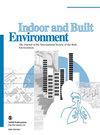Study on the effect of humidity on formaldehyde emission parameters of wood-based panels
IF 2.9
3区 工程技术
Q2 CONSTRUCTION & BUILDING TECHNOLOGY
引用次数: 0
Abstract
Wood-based panels are a significant source of indoor volatile organic compounds (VOCs), crucial for managing indoor pollution. The emissions from wood-based panels are influenced by both intrinsic factors, including their composition and manufacturing process, and extrinsic environmental conditions, such as temperature and humidity. In this paper, the emission of formaldehyde in plywood was studied under different temperature conditions (15°C, 23°C, 32°C and 37°C) and different humidity conditions (40%, 60% and 80%) by environmental chamber method. To understand the influence of relative humidity on the key parameters of panels from a mechanism perspective, this paper investigates the influence of relative humidity on the initial emittable concentration of formaldehyde, based on the hydrolysis reaction of urea-formaldehyde resin. Concurrently, the molecular dynamics and porous panels model were amalgamated to assess the influence of relative humidity on both the partition and diffusion coefficient. To simulate the emission process in a real environment, a control equation that allows for variations in both temperature and humidity is needed. This paper employs the method of variable separation to derive a simplified control equation. Subsequently, experimental data was utilized to validate the derived equation’s effectiveness within the practical indoor environmental range.湿度对人造板甲醛释放参数影响的研究
人造板是室内挥发性有机化合物(VOC)的重要来源,对治理室内污染至关重要。人造板的释放量既受内在因素(包括其成分和制造工艺)的影响,也受外在环境条件(如温度和湿度)的影响。本文采用环境室法研究了胶合板在不同温度条件(15°C、23°C、32°C 和 37°C)和不同湿度条件(40%、60% 和 80%)下的甲醛释放量。为了从机理角度了解相对湿度对板材关键参数的影响,本文基于脲醛树脂的水解反应,研究了相对湿度对甲醛初始可释放浓度的影响。同时,结合分子动力学和多孔板模型,评估了相对湿度对分配系数和扩散系数的影响。为了模拟真实环境中的排放过程,需要一个允许温度和湿度变化的控制方程。本文采用变量分离法推导出一个简化的控制方程。随后,利用实验数据验证了推导出的方程在实际室内环境范围内的有效性。
本文章由计算机程序翻译,如有差异,请以英文原文为准。
求助全文
约1分钟内获得全文
求助全文
来源期刊

Indoor and Built Environment
环境科学-工程:环境
CiteScore
6.40
自引率
25.00%
发文量
130
审稿时长
2.6 months
期刊介绍:
Indoor and Built Environment publishes reports on any topic pertaining to the quality of the indoor and built environment, and how these might effect the health, performance, efficiency and comfort of persons living or working there. Topics range from urban infrastructure, design of buildings, and materials used to laboratory studies including building airflow simulations and health effects. This journal is a member of the Committee on Publication Ethics (COPE).
 求助内容:
求助内容: 应助结果提醒方式:
应助结果提醒方式:


